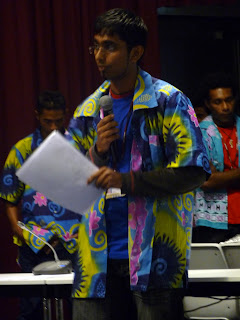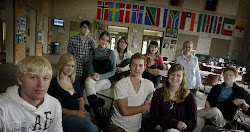
After seemingly infinite hours of travel, we arrived at the Copenhagen Airport in a state of severe disorientation.
Pictured: Luke & Ashley
 The first experiences we had in Copenhagen would ultimately foreshadow the entirety of the trip. That goes to say: experiencing public transportation was one of the key aspects to this field study.
The first experiences we had in Copenhagen would ultimately foreshadow the entirety of the trip. That goes to say: experiencing public transportation was one of the key aspects to this field study.Pictured: Jessica, Luke, Tara, Deon, David, Katie, & Ashley
 Our first full day in Sweden we traveled to meet the hospitable Mayor of Landskrona who provided us with informational books about the city.
Our first full day in Sweden we traveled to meet the hospitable Mayor of Landskrona who provided us with informational books about the city. 
 I spent much of the first day of the conference exploring various parts of the Bella Center. The area displayed was one of the busiest in the center, serving as a path between the large forum center and more specialized meeting rooms.
I spent much of the first day of the conference exploring various parts of the Bella Center. The area displayed was one of the busiest in the center, serving as a path between the large forum center and more specialized meeting rooms. This is one of the two huge plenary rooms where the official business of the Convention was carried out.
This is one of the two huge plenary rooms where the official business of the Convention was carried out. This is the largest of the open delegate working spaces. I often found myself typing furiously in this sea of laptops with individuals from at least four distinctly different world regions surrounding me. It was an incredible place to sit in awe and soak up the sheer magnitude of the conference.
This is the largest of the open delegate working spaces. I often found myself typing furiously in this sea of laptops with individuals from at least four distinctly different world regions surrounding me. It was an incredible place to sit in awe and soak up the sheer magnitude of the conference. The official SESEF Delegation Photo.
The official SESEF Delegation Photo.  This is a display of a usual morning at the COP15. We congregated in the forum, discussed the exciting events of the day, updated the blog, checked email, and scampered off to whatever side events or plenary sessions provoked intrigue.
This is a display of a usual morning at the COP15. We congregated in the forum, discussed the exciting events of the day, updated the blog, checked email, and scampered off to whatever side events or plenary sessions provoked intrigue.  The conference encompassed a huge variety of side events from all ends of the earth. At this particular event, I was able to witness a traditional dance from a woman of a small island nation. Her performance, rich in cultural identity, was a powerful mechanism for reminding people just what is at stake if we don't work to combat the effects of climate change.
The conference encompassed a huge variety of side events from all ends of the earth. At this particular event, I was able to witness a traditional dance from a woman of a small island nation. Her performance, rich in cultural identity, was a powerful mechanism for reminding people just what is at stake if we don't work to combat the effects of climate change.  I also had the chance to hear the powerful words of the Intergovernmental Panal on Climate Change (IPCC) as they discussed plans for their Fifth Assessment Report.
I also had the chance to hear the powerful words of the Intergovernmental Panal on Climate Change (IPCC) as they discussed plans for their Fifth Assessment Report.  One of the most influental people attending the conference was Rajendra K. Pachauri: the highly regarded chairman of the IPCC.
One of the most influental people attending the conference was Rajendra K. Pachauri: the highly regarded chairman of the IPCC. Some of the other delegates and I attended various scheduled youth events. This particular event in diplay entailed the creation of a "rainstorm" to call attention to the youth's demand for climate justice.
Some of the other delegates and I attended various scheduled youth events. This particular event in diplay entailed the creation of a "rainstorm" to call attention to the youth's demand for climate justice. Throughout the course of the conference, interviews were collected from a wide variety of people wherever the opportunity presented itself.
Throughout the course of the conference, interviews were collected from a wide variety of people wherever the opportunity presented itself.  Occasionally we became the subject of an interview as well. At this time, Deon and Katie were being interviewed by people who wanted a youth perspective on the controversial riots at the conference.
Occasionally we became the subject of an interview as well. At this time, Deon and Katie were being interviewed by people who wanted a youth perspective on the controversial riots at the conference.  We had the opportunity to skype with students back at SES during their classtime. In this photo, David is conveying something of importance to classmates back home.
We had the opportunity to skype with students back at SES during their classtime. In this photo, David is conveying something of importance to classmates back home.  The last day we attended the conference, riots broke out around the perimeter of the conference center. One of the Swedish students named Amanda exemplified the general mass of people attempting to exit the building with her look of anxious confusion.
The last day we attended the conference, riots broke out around the perimeter of the conference center. One of the Swedish students named Amanda exemplified the general mass of people attempting to exit the building with her look of anxious confusion.  I (clearly) took pictures to pass the time on our various adventures with public transportation.
I (clearly) took pictures to pass the time on our various adventures with public transportation. One of the days not at the conference was spent in the beautiful city of Lund. We toured a cathedral, roamed the streets, and enjoyed the festive sounds of the Santa Lucia concert.
One of the days not at the conference was spent in the beautiful city of Lund. We toured a cathedral, roamed the streets, and enjoyed the festive sounds of the Santa Lucia concert. The holiday spirit could be seen everywhere we went in Sweden. In the transit center, we stumbled upon a group of students singing the traditional holiday music.
The holiday spirit could be seen everywhere we went in Sweden. In the transit center, we stumbled upon a group of students singing the traditional holiday music.  We spent an afternoon taking in the sights of Copenhagen.
We spent an afternoon taking in the sights of Copenhagen. After presenting at the Midwest Youth side event, we had the opportunity to network and make some valuable acquaintances.
After presenting at the Midwest Youth side event, we had the opportunity to network and make some valuable acquaintances. 















